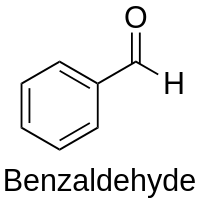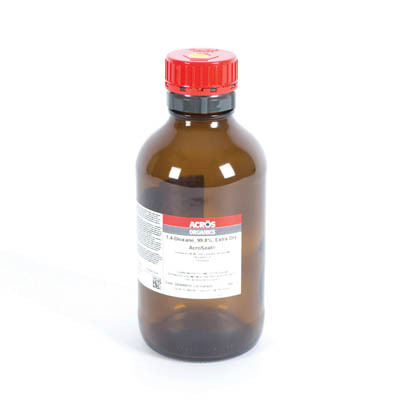Common information
Benzaldehyde (C6H5CHO) is an organic compound consisting of a benzene ring with a formyl substituent. It is the simplest aromatic aldehyde and one of the most industrially useful.nIt is a colorless liquid with a characteristic almond-like odor. The primary component of bitter almond oil, benzaldehyde can be extracted from a number of other natural sources. Synthetic benzaldehyde is the flavoring agent in imitation almond extract, which is used to flavor cakes and other baked goods.
As of 1999, 7000 tonnes of synthetic and 100 tonnes of natural benzaldehyde were produced annually. Liquid phase chlorination and oxidation of toluene are the main routes. Numerous other methods have been developed, such as the partial oxidation of benzyl alcohol, alkali hydrolysis of benzal chloride, and the carbonylation of benzene.
A significant quantity of natural benzaldehyde is produced from cinnamaldehyde obtained from cassia oil by the retro-aldol reaction: the cinnamaldehyde is heated in an aqueous/alcoholic solution between 90 °C and 150 °C with a base (most commonly sodium carbonate or bicarbonate) for 5 to 80 hours, followed by distillation of the formed benzaldehyde. This reaction also yields acetaldehyde. The natural status of benzaldehyde obtained in this way is controversial.Some other foods are subjected to undeniably greater reactive conditions, such as masa flour, which is made by treating corn flour with sodium hydroxide (lye). When food is cooked it is often altered by catalytic oxidation conditions in cooking that can even impart some amount of toxicity (however insignificant). Still, subjecting cinnamaldehyde to the retro aldol reaction is undoubtably a chemical conversion into a distinctly separate chemical.
Properties
CAS Number: 100-52-7
Chemical formula: C7H6O
Molar mass: 106.124 g/mol
Density: 1.044 g/mL, liquid
Melting Point: −26 °C (−70.82 °F; 216.03 K)
Boiling point: 178.1 °C (352.6 °F; 451.2 K)
Solubility in water: 6.95 g/L (25 °C)
Appearance: colorless liquid;
Soluble in ethanol, ether and other organic solvents. Forms azeotropic mixtures with ortho-cresol, benzyl chloride, phenol and other organic substances.
IUPAC name: Benzaldehyde
Systematic IUPAC name: Benzenecarbaldehyde
Other names: Benzenecarbonal; Benzenecarboxaldehyde; Benzoic aldehyde; Phenylmethanal
Synthesis
Benzaldehyde synthesis from benzyl alcohol is the oxidation of benzyl alcohol to benzaldehyde in high yield using aqueous nitric acid as an oxidizer. Other methods of oxidizing benzyl alcohol to benzaldehyde are well-known, including those using chlorochromates, persulfate, or activated manganese dioxide.
Ligal status
Benzaldehyde is difficult to acquire in some countries, due to its use in the manufacturing of illegal amphetamine-class drugs. In US it is considered a List I chemical, meaning it cannot be legally purchased without a permit. These chemicals are designated as those that are used in the manufacture of the controlled substances and are important to the manufacture of the substances. In the EU however, its sale is not restricted and can be bought online or from chemical suppliers.
A good source of benzaldehyde is bitter almond oil, which is mostly crude benzaldehyde. It can be purified via vacuum distillation or steam distillation in an inert atmosphere. However, keep in mind that since the bitter almond oil is basically crude benzaldehyde, legally there's no distinction between the oil and impure benzaldehyde. In US it's illegal to import bitter almond oil without proper paperwork.
Legal application
As used in food, cosmetics, pharmaceuticals, and soap, benzaldehyde is "generally regarded as safe" (GRAS) by the US FDA and FEMA. This status was reaffirmed after a review in 2005. It is accepted in the European Union as a flavoring agent.
Benzaldehyde is used as a bee repellent. A small amount of benzaldehyde solution is placed on a Fume Board near the honeycombs. The bees then move away from the honey combs to avoid the fumes. The beekeeper can then remove the honey frames from the bee hive with less risk to both bees and beekeeper.
Benzaldehyde is commonly employed to confer almond flavor to foods and scented products. In industrial settings, benzaldehyde is used chiefly as a precursor to other organic compounds, ranging from pharmaceuticals to plastic additives. The aniline dye malachite green is prepared from benzaldehyde and dimethylaniline. Benzaldehyde is also a precursor to certain acridine dyes. Via aldol condensations, benzaldehyde is converted into derivatives of cinnamaldehyde and styrene.
Illegal application
Benzaldehyde is used as precursor in Henry reaction for 1-phenyl-2-nitropropene, which is used for Amphetamine synthesis as a direct precursor. Also, It is used as precursor in 1-phenyl-2-propanone synthesis.
Storage
Benzaldehyde is rapidly oxidized by air oxygen to benzoyl peroxide (explosive), further turning into benzoic acid. Since benzaldehyde is sensitive to air and light, it should be stored in amber or dark glass bottles, which are then made air-tight by sealing them with sealing tape, like parafilm. Schlenk flasks can also be used to store this compound.
Disposal
Benzaldehyde should be mixed with a more volatile solvent and safely burned outside. Another more lengthy route involves oxidation to benzoic acid, which is less volatile and can be safely dumped in trash or poured down the drain.
If your benzaldehyde have a hue or it stayed long time under air exposure, you should distill it before using. Distillation of benzaldehyde may be carried out at atmospheric or elevated pressure, but preferably at a reduced pressure, such as a pressure of between about 2 and 35 kPa. In the process of the present invention, the loss of benzaldehyde is relatively small, usually in the range of about 1 to 5% by weight.
Toxicity and rules for handling the substance
The smell of this substance is clearly feel at a concentration of 3 mg/m3. Toxicology studies indicate that it is safe and non-carcinogenic in the concentrations used for foods and cosmetics, and may even have anti-carcinogenic (anti-cancer) properties. Self-ignition temperature 205 °C; temperature limits of explosiveness 58-80°C. Benzaldehyde is irritating to the eyes and upper respiratory tract. LD50 1.3 g/kg (rats, oral). For a 70 kg human, the lethal dose is estimated at 50 mL. An acceptable daily intake of 15 mg/day has been identified for benzaldehyde by the United States Environmental Protection Agency. Benzaldehyde does not accumulate in human tissues. It is metabolized and then excreted in urine.
